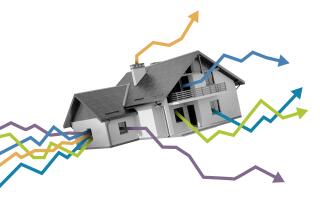The Downbeat Goes On for County Housing Market
- Share via
There’s a lot of good news being reported these days about the Orange County economy. It looks as though 1996 will have been a very good year and 1997 promises to be even better. Where the euphoria breaks down is when we get to the subject of home prices.
Since home ownership is such a revered thing in American society and our tax laws promote it so vigorously, it has become almost a given that it must also be a good investment. For those who bought at the peak in the late 1980s, and many others who refinanced along the way (not to mention their lending institutions), it has instead been a nightmare. But the recession is over, right? So things will return to normal. Wrong.
While housing “affordability” is high due to a combination of moderately low interest rates and stable “real” household income, and sales of existing homes are brisk, the median home price declined again in November from its 12-month peak in May. It now stands at $190,000. In its 1996 outlook report, the Southern California Assn. of Governments remarked that the Southern California real estate market “remains weak.” While 1996 will show improvement over 1995, with 9,500 more dwelling units built and a 13.3% increase in residential permit values, there is no spillover effect on the prices of existing homes.
One reason that the median price of existing homes has not risen in the face of employment growth in excess of new home construction is that mortgage delinquencies are still running at historic highs, resulting in annual foreclosures of approximately 50,000 per year in the SCAG region. That has a depressing effect in that these properties are typically discounted for quick sale by the mortgage lenders who become their reluctant owners.
There still are a significant number of existing homes out there for which the mortgage exceeds the market value, so it’s unlikely this trend will be interrupted soon. Feeding this unfortunate situation is the tremendous consumer debt in the form of expensive credit card balances and home equity lines of credit that has existed for the past few years.
But by far the most important factor that mitigates against a return to the good old days of soaring home prices lies behind the employment numbers. In the 1993-96 post-recession period, Orange County’s employment base grew by 61,000 jobs, almost 36,000 of them (59%) in the lower-wage services sector. In 1996, the overall average hourly wage in the county was $13.46, but this average masks tremendous variation in average wages by sector, from approximately $8.50 per hour in services to $20.26 per hour in engineering and management. A wage of $8.50 per hour equates to $18,000 annually.
It would take three income earners per household at $18,000 each to reach the income level needed to buy Orange County’s median-priced home using typical underwriting criteria. That just isn’t reality.
Contrast our situation to that of Silicon Valley, a comparison we often like to make because of Orange County’s entrepreneurial and high-tech character. Silicon Valley firms will have created nearly 100,000 jobs in 1996 alone, most of them in the higher-paying engineering and management positions, just the opposite of Orange County’s mix of new jobs. That 100,000 jobs in one year compared to 61,000 over three years here. No wonder Santa Clara County home prices are soaring. Even during the recession years, the drop in the median home price in Santa Clara County was small. And now, what with the tremendous expansion that’s taking place, the median home price is up 10.5% in the first 10 months of 1996, to a level of $264,000.
What happened in Orange County over the past several years is that our manufacturing sector shrank its employment and, while recently adding to payrolls, is effectively making more money with fewer people. The unemployment statistics don’t tell the real story either. While the unemployment rate for Orange County is a low 3.5%, many present and former Orange County employees live in Los Angeles, Riverside and San Bernardino, counties where the unemployment rate is more than twice as high. Since unemployment statistics refer to where people live, not where they work, we essentially export unemployment along with the host of products and services that is transforming the county into a major international business center.
The ingredients required to fuel a major resurgence in overall Orange County home prices in the near future are simply not there. New home construction will be concentrated in the lower-price ranges. We also will see increased activity in the construction of multifamily dwellings, as more people come into the rental market.
So if you’re counting an appreciation to make your home purchase look like a good investment, don’t hold your breath. Rather, get out there and mow the lawn, fix the rain gutters and enjoy the “psychic income” associated with home ownership. It’s all you’re going to get for a while.
More to Read
Inside the business of entertainment
The Wide Shot brings you news, analysis and insights on everything from streaming wars to production — and what it all means for the future.
You may occasionally receive promotional content from the Los Angeles Times.








